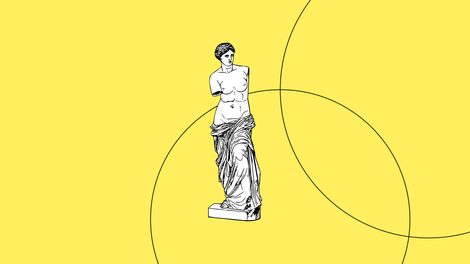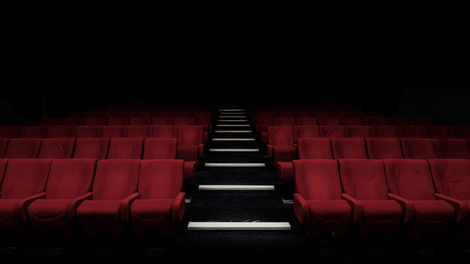
Art Deco, similar to Art Nouveau, is an art style that attempts to permeate practical objects with artistic touches. This movement is different from the fine arts (painting and sculpture), where the art object has no proper function.
The Art Deco era fell between the two World Wars, and symbolized the West’s modern vision of progress. This modern style movement was particularly noticeable in France and the United States.
Some of the most prominent names of that style period are Émile-Jacques Ruhlmann, Paul Poiret, Francis Jourdain, Paul Manship, Jean Dunand, William van Alen, Marcel Coard, Paul Follot, Jean Dupas, Paul Ruaud, Jacques Doucet, Jacques Lipchitz, Jean Patou, Jean Gaudin, Maurice Dufrène and Paul Iribe.
The American version of the Art Deco style, Streamline Moderne, was a stripped-down, sleek version of the more elaborate European Art Deco style. Art Deco has derived its name from the International Exhibition of Modern Decorative and Industrial Arts. The term “arts decorates” was first used in France in 1858 before the iconic label “Art Deco” was used.
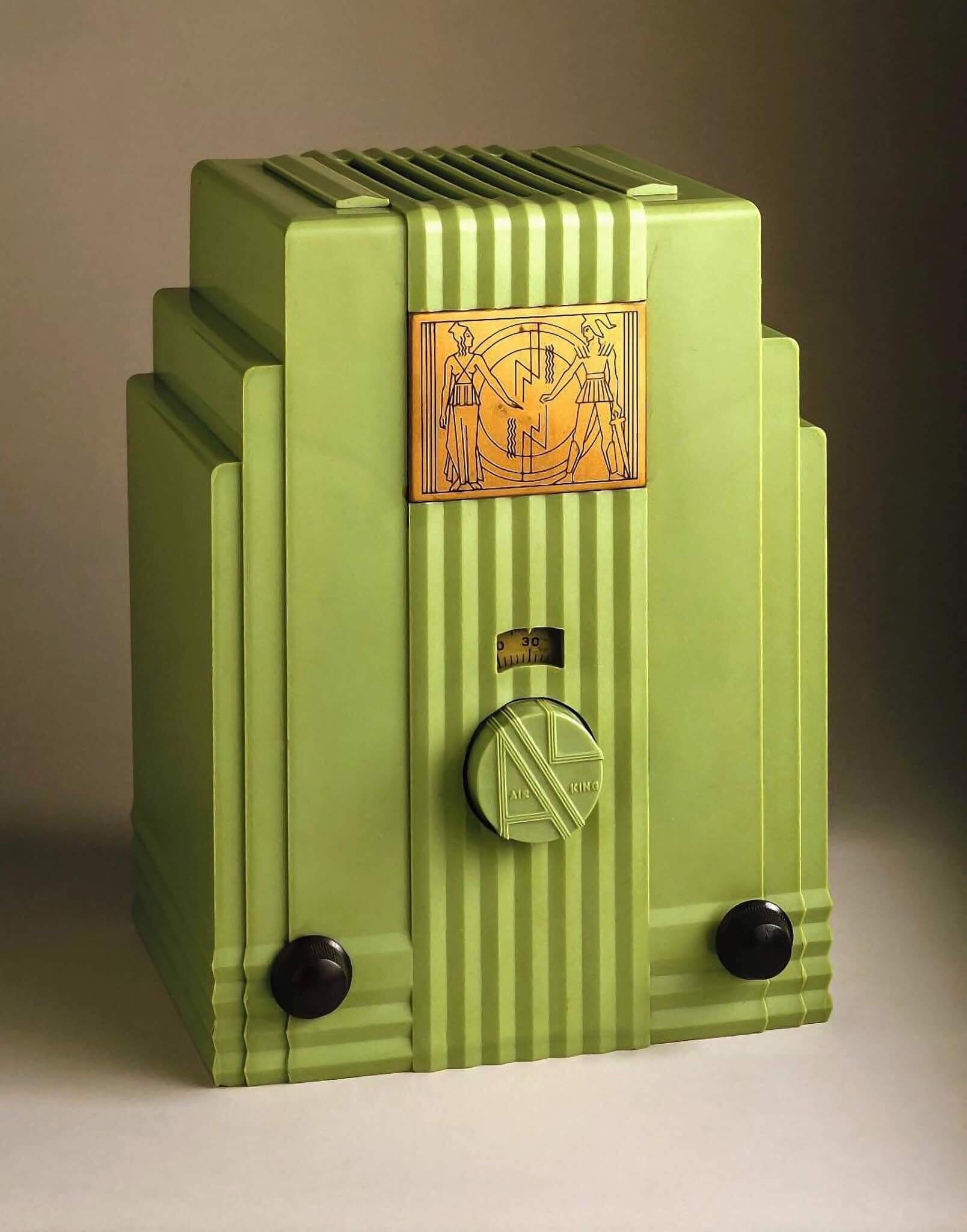
The Art Deco aesthetic first emerged in France before World War One. But this movement was only announced to the public in 1925 at the Exposition Internationale des Arts Décoratifs et Industriels Modernes; the exhibition was inspired loosely by the concept of the World’s Fair.
With the effects of the Industrial Revolution coming into play, artists were inspired to produce a style that would symbolize tastefulness, progress, and modernity. The Art Deco movement restored France’s reputation as a first-class creator of decorative arts once again.
The Salon or Société des artistes décorateurs in France (Society of Decorative Arts) designed furniture, decorative objects, interiors, and art, with expensive materials that helped raise the respect for art objects of daily usage. One of the primary goals of Art Deco was to change the hierarchical organization of the visual arts that demoted decorative artists to a lower status compared to the more traditional painting and sculpting disciplines. The Art Deco movement deviated from the Art Nouveau and Arts and Crafts styles, which accentuated the uniqueness of handmade objects and flowing organic forms.
Art Deco's more equitable aim was to make aesthetically pleasing, machine-made objects available to everyone.
The main characteristic of the Art Deco style was its absolute admiration for the concept of modernity and the advancement of machinery and technology.
Jumpstart your ideas with Linearity Curve
Take your designs to the next level.
The exhibition that started the Art Deco movement
The French government funded and organized the International Exhibition of Modern Decorative and Industrial Arts. This exhibition was deemed responsible for introducing the Art Deco style into the art world.
More than 15,000 artists, architects, and designers from major cities presented their works at this exhibition for seven months, with over 16 million visitors.
This exhibition was regarded as the catalyst that started the Art Deco movement.
The only requirement to exhibit at this fair was that all artworks needed to be thoroughly modern, which clearly illustrates the focus of the Art Deco movement.
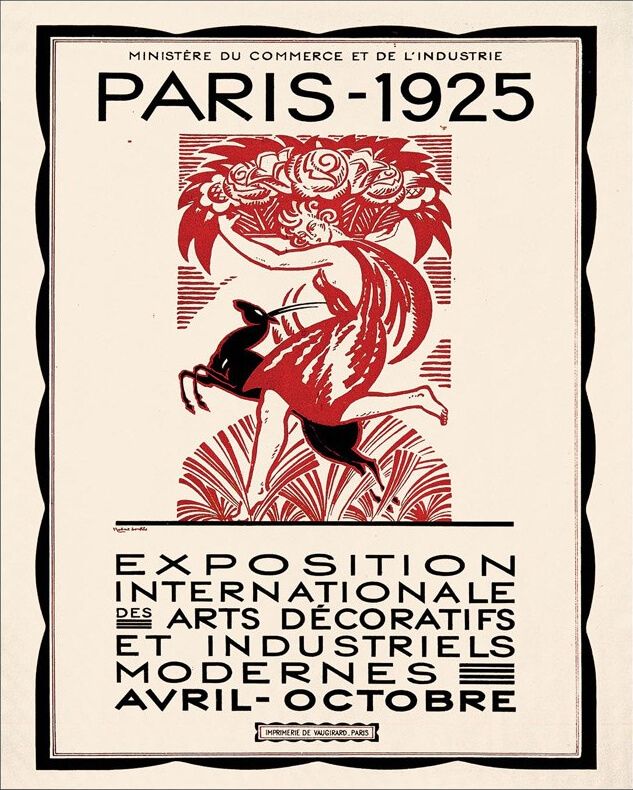
The exhibition proved to be incredibly popular and widely visited, which helped establish Art Deco design in art history. The show also prompted the official name of the movement, Arts Decorates. Art Deco became popular and swept even to South America.
The Art Deco movement is one of the historical styles that slowly expanded the definition of art beyond painting and sculpture into other areas, such as glassware and jewelry. Those who created Art Deco objects of daily usage that were not considered “fine art” before were suddenly viewed as artists instead of mere artisans. Even the richly ornated wallpapers with geometric shapes were considered art. By the 1920s, Art Deco was a lavish major style movement, a counterpoint to the more clean and reserved formal styles of the Bauhaus and De Stijl aesthetics.
Like the Bauhaus and De Stijl movement, Art Deco practitioners embraced technological innovation, industrial materials, and mechanization but with a more ornated and luxurious expression. Art Deco, with its appreciation of modern forms, progress, modern materials, and luxurious exuberance, symbolized perfectly the flourishing post-war America with its new inventions that were available to even the average person. The Art Deco style perfectly reflected this intoxicating progress.

The fade-out
During the Great Depression in the 1930s, Art Deco became more subdued as popular taste shifted towards less boastful materials like stainless steel, chrome plating, and plastic.
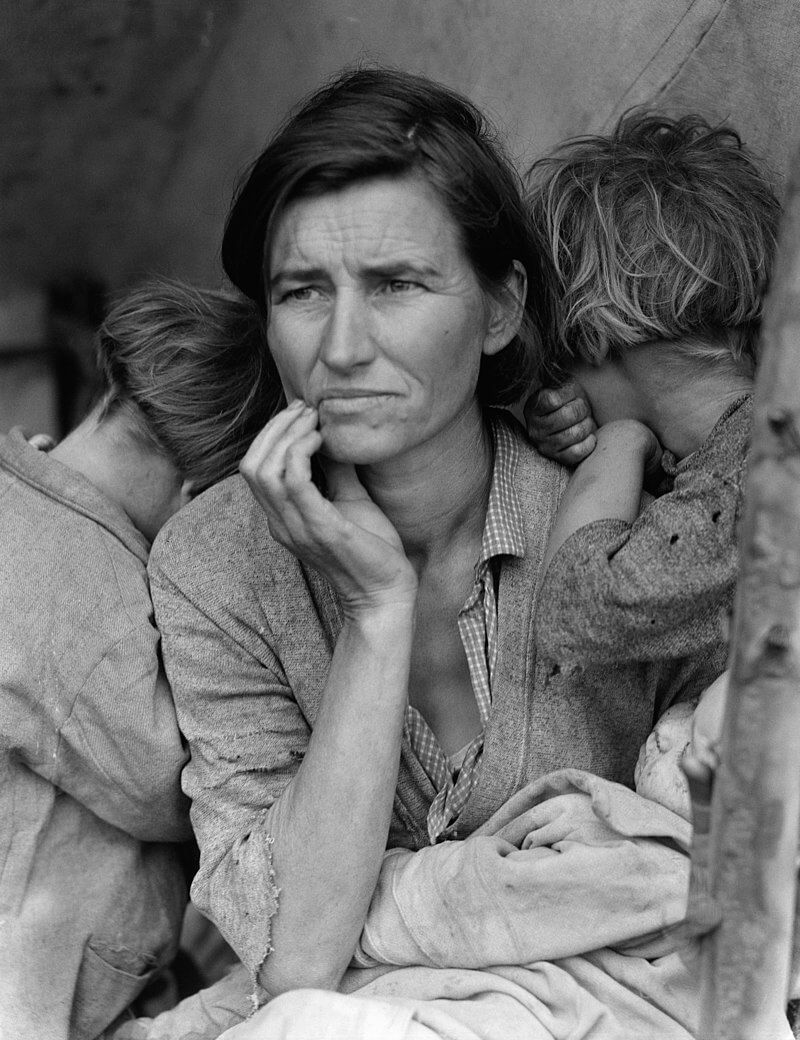
The emergence of World War Two heralded the end of the Art Deco movement. During wartime, the restraint of society made the Art Deco style seem even more decadent than it already appeared to be. It was a decadence that suddenly seemed ill-fitting in a dark, austere, and troubled time.
The limited supply of metal was used in building military weapons and equipment instead of using it for decorating buildings and interior spaces. In a society that was so troubled at the time, objects like furniture were no longer perceived as essential status items.
The style attributes of Art Deco
Art Deco shapes
The lines were harmonious, vertical, repetitive, symmetrical, clean, geometric forms, sleek, and uncomplicated. The overall aesthetic is streamlined and polished; the shapes consist of basic forms with clean geometrical lines. The forms and lines of Art Deco were directly inspired by the aesthetics of Art nouveau, Cubism, Constructivism, Bauhaus, De Stijl, and Futurism.
Characteristic motifs included nude female figures, animals, foliage, and sun rays, in all forms. The main visual features of the Art Deco aesthetics were derived from the repetitive use of linear shapes that included triangular, trapezoidal, chevron-patterned forms. Objects like humans, animals, and even flowers were depicted in a highly stylized and streamlined way on decorative objects to maintain the general aesthetic. The features of Art Deco artworks reflected those attributed to mechanical objects like shiny surfaces, straight lines, and mass production.
Further aesthetic influences of the Art Deco modern style were Russian ballets, traditional folk art, iconography, and motifs from various cultures. Especially appreciated were ancient motifs from Egyptian, Mesopotamian, Asian, Mesoamerican, and African Art. Especially the integration of motives from Egyptian art soared after the discovery of Tutankhamun's tomb in 1922.
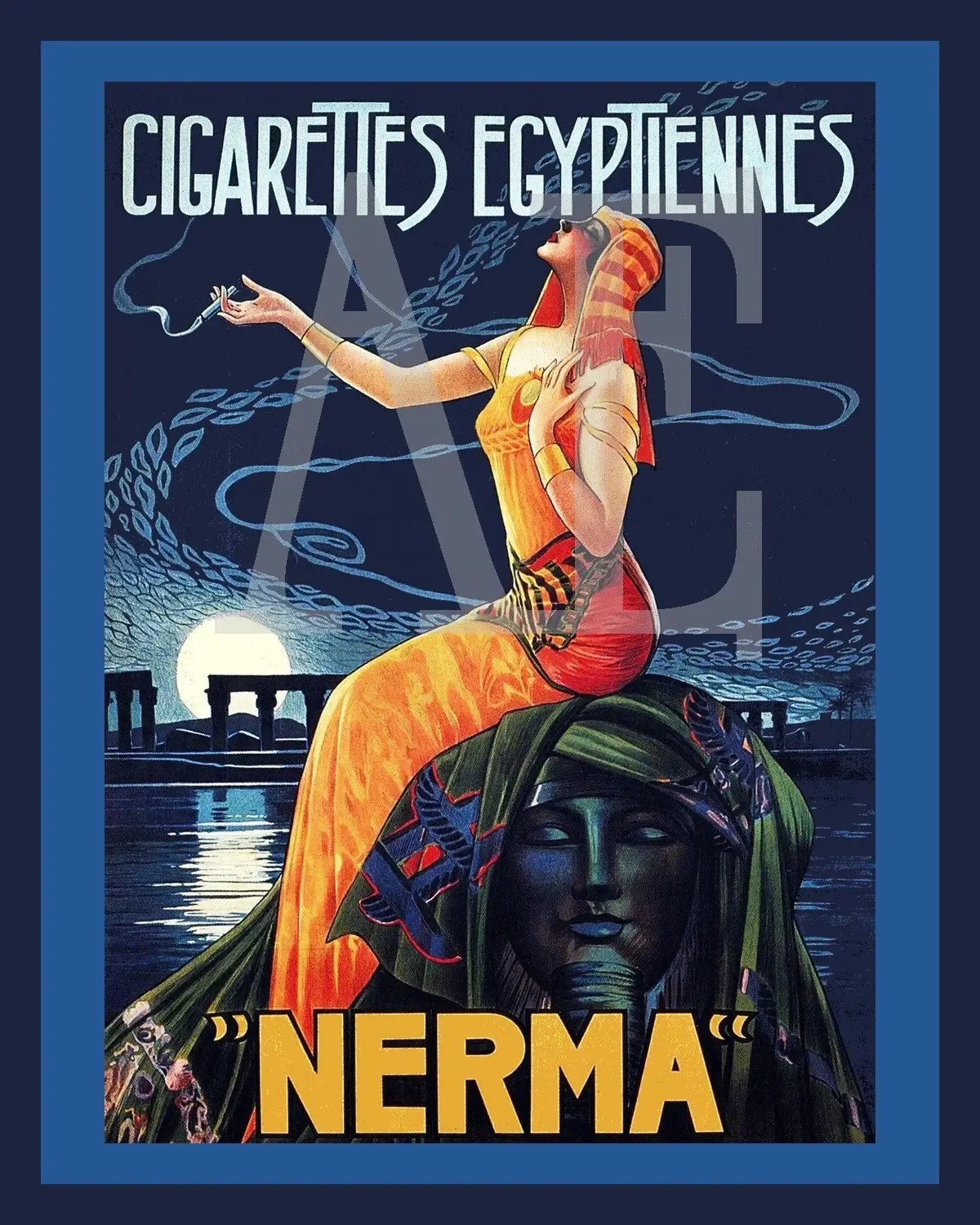
Art Deco color palette
The color palette of the Art Deco style period has been influenced by the bold and vivid colors of Fauvism. The luxurious aspects were represented with jewel-toned colors like a deep blue, purple, and dark burgundy with shimmery gold or silver accents.
The materials
Very expensive and often exotic materials were used for the creation of Art Deco objects, a combination of artificial materials like plastics, especially Bakelite; vita-glass; and ferroconcrete, glass, reinforced concrete, and stainless steel, and natural ones like jade, silver, ivory, obsidian, chrome, and rock crystal. The heavy integration of artificial materials was perceived as a symbol of progression. To add a luxurious look and feel, artists included rare and unusual materials in their artworks, such as ivory, horn, and zebra skin.
The style reflects speed, time, and space using bold geometric forms and vivid shades. Machine-made objects became the main inspiration for Art Deco; it is a celebration of progress, a modern aesthetic representing the 20th century. Almost everything could be considered art, from clocks, glassware, and ashtrays to more complex objects like cars and buildings. Art Nouveau emphasized hand-crafted uniqueness; Art Deco, on the contrary, celebrated the mass production of modern times. However, it has to be mentioned that Deco pieces were rarely mass-produced.
Art Deco, like the Art Nouveau movement, was less connected to the traditional superior forms of art that were made up of painting and sculpture. This led to Art Deco being experimented with within the disciplines of design, furniture, architecture, and buildings.
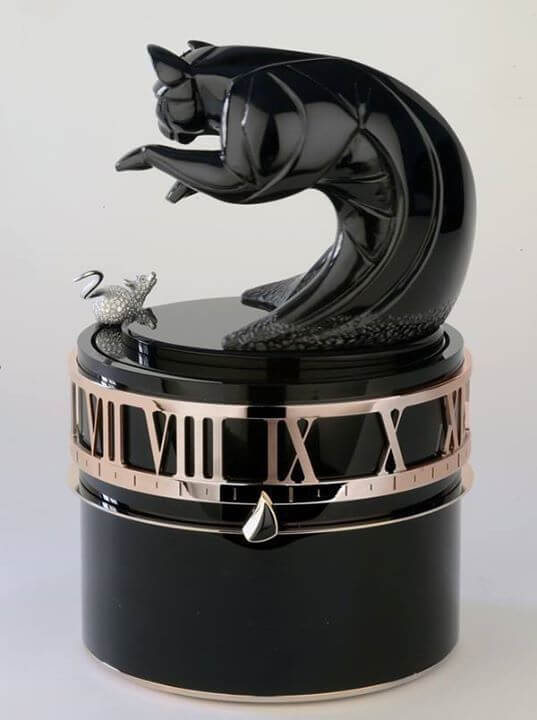
The polished and streamlined style of Art Deco symbolized a longing and desire to be free of the past and to welcome the manufactured and machine-driven future.
Late Art Deco
By 1925, two completely different schools coexisted within the Art Deco movement. These schools consisted of the traditionalists and the modernists. The traditionalists were the artists who had established the Society of Decorative Artists. This school of Art Deco was known for its combination of advanced forms with conventional techniques and expensive exotic materials.
Discover the Precision of Linearity’s Pen Tool
Master the art of vector drawing with our advanced Pen Tool. Learn how to create smooth, precise lines and shapes for professional-grade designs.
Contrary, the modernists emphasized their rejection of the past. Artists within this Art Deco group wanted to create an artistic style based on new developments in technologies, simplicity, an absence of luxurious decoration, and cheaper materials and mass production.
Art Deco glassware and furniture
Art Deco glass uses mainly geometric patterns, bold colors, stylized female figures, and animal motifs.
The most prominent designers of Art Deco glass were Rene Lalique, Maurice Marinot, Daum Freres, Marius Sabino, Etling, Schneider, Gabriel Argy-Rousseau, and Francois Decorchemont.
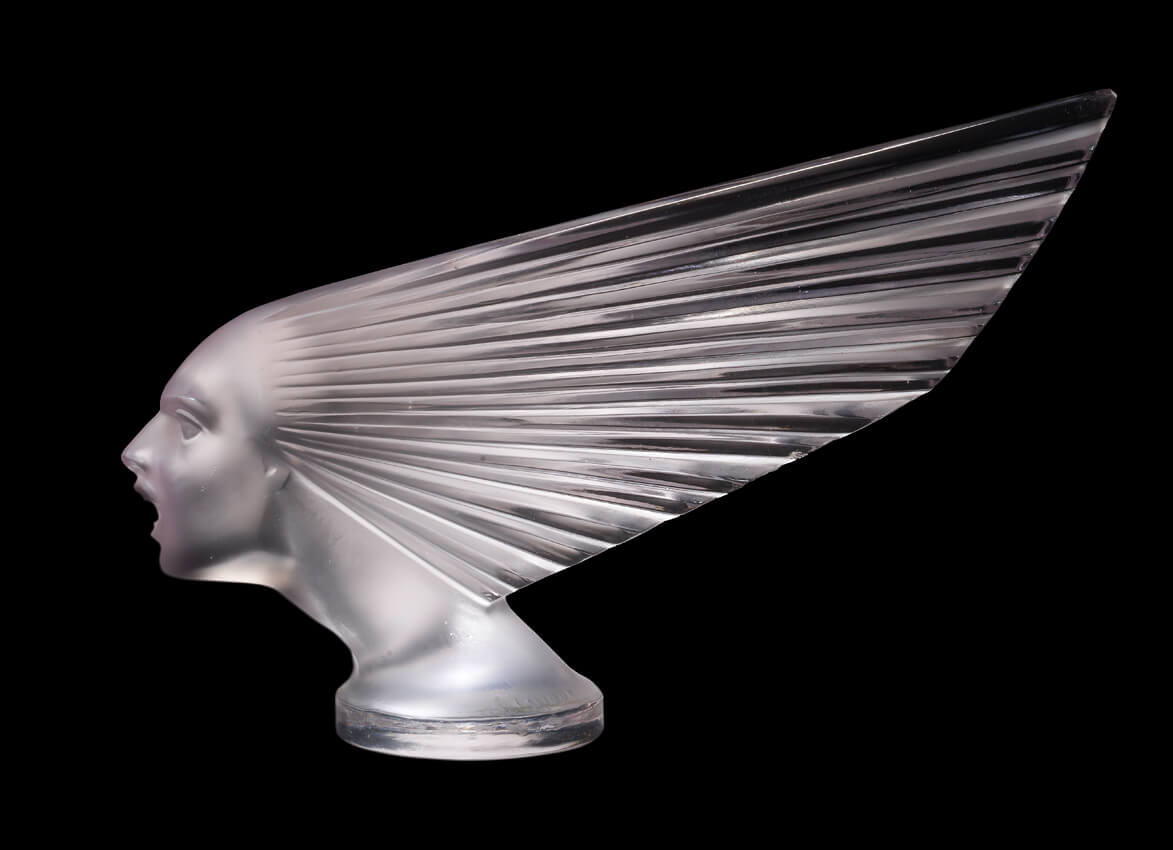
In Sweden, Art Deco glass was made by Orrefors; in Britain, it was produced by Jobling's, Bagley, Stevens & Williams, Davidson, Sowerby, and Moncrieff.
In Belgium, there was a series of Art Deco pieces made by Val St. Lambert, and in Germany, it was made by August Walther and Sohn.
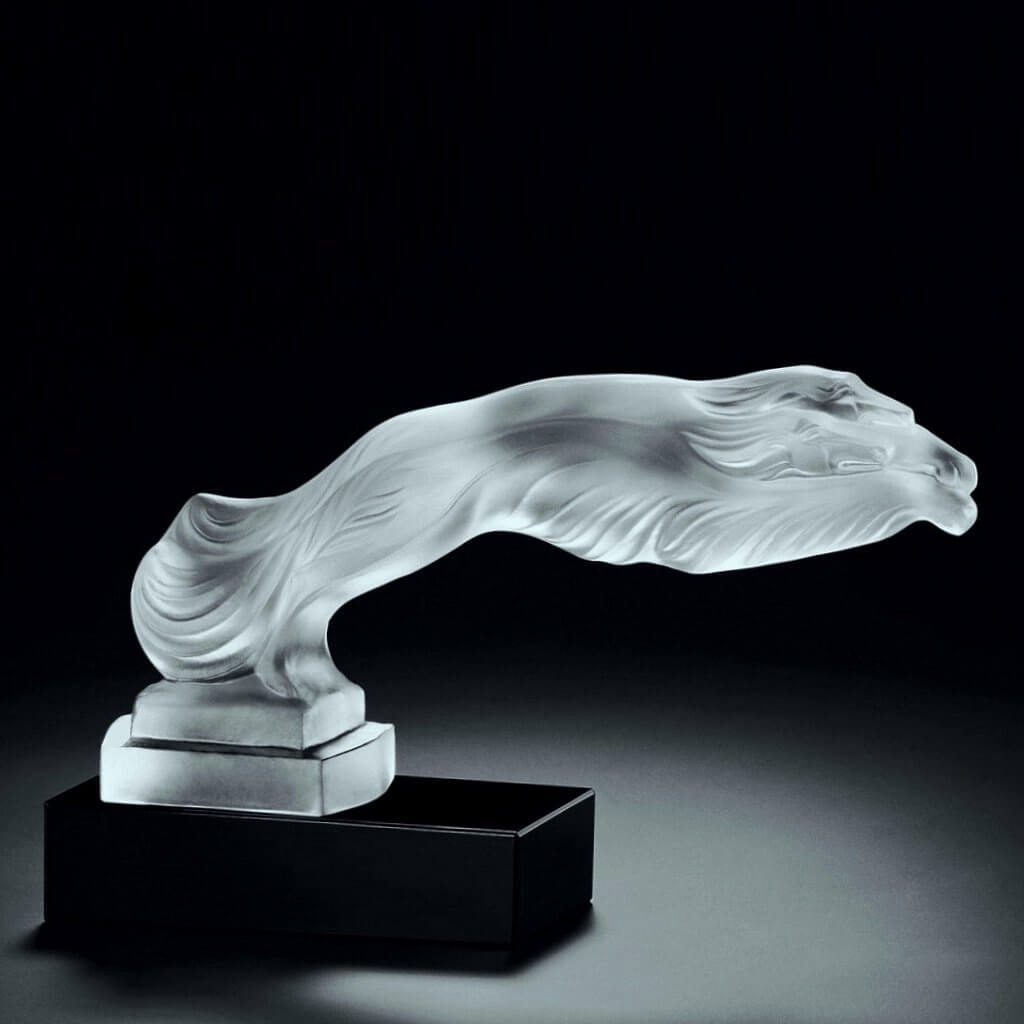
Art Deco furniture
Characteristics of Art Deco Furniture were exotic folding screens, metallic fabrics, stained glass, cocktail cabinets, ornamental lighting, and angular geometric furniture.
Bold colors were combined with exotic and expensive materials like exotic wood, violetwood, Amboyna burl, Macassar ebony, mahogany lacquer, wood inlay, marquetry, metal, and leather. Luxurious embellishments and accents were created with onyx, mirrors, jade, ivory, and Murano glass. Due to the expensive materials, it was challenging to produce furniture in series.
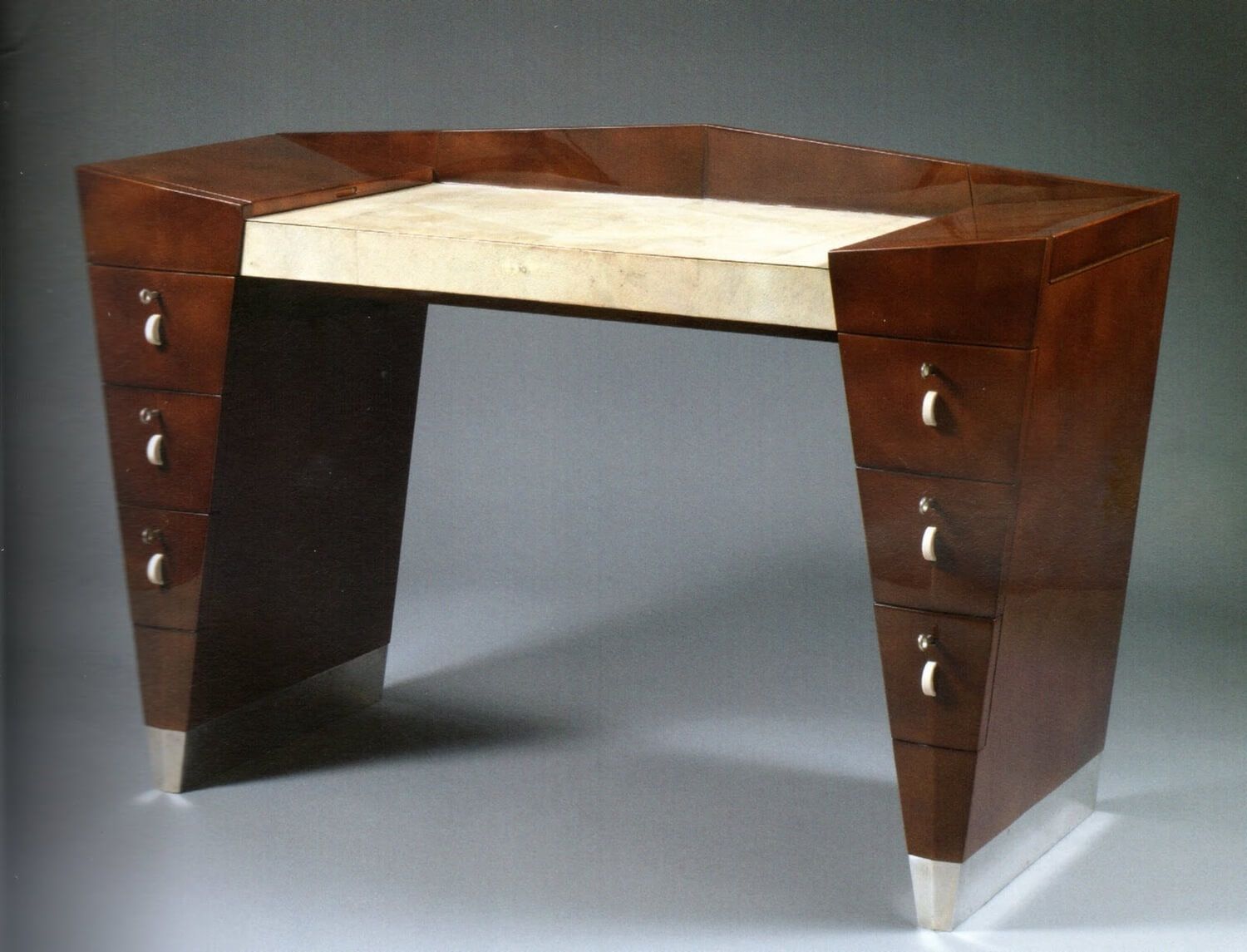
Art Deco architecture
The architectural style of Art Deco was the most significant genre of this style, as it has created some of the most well-known modern public buildings in American cities to date. These include Rockefeller Centre, the Empire State Building, and the breathtaking Chrysler Building, all built in New York City.
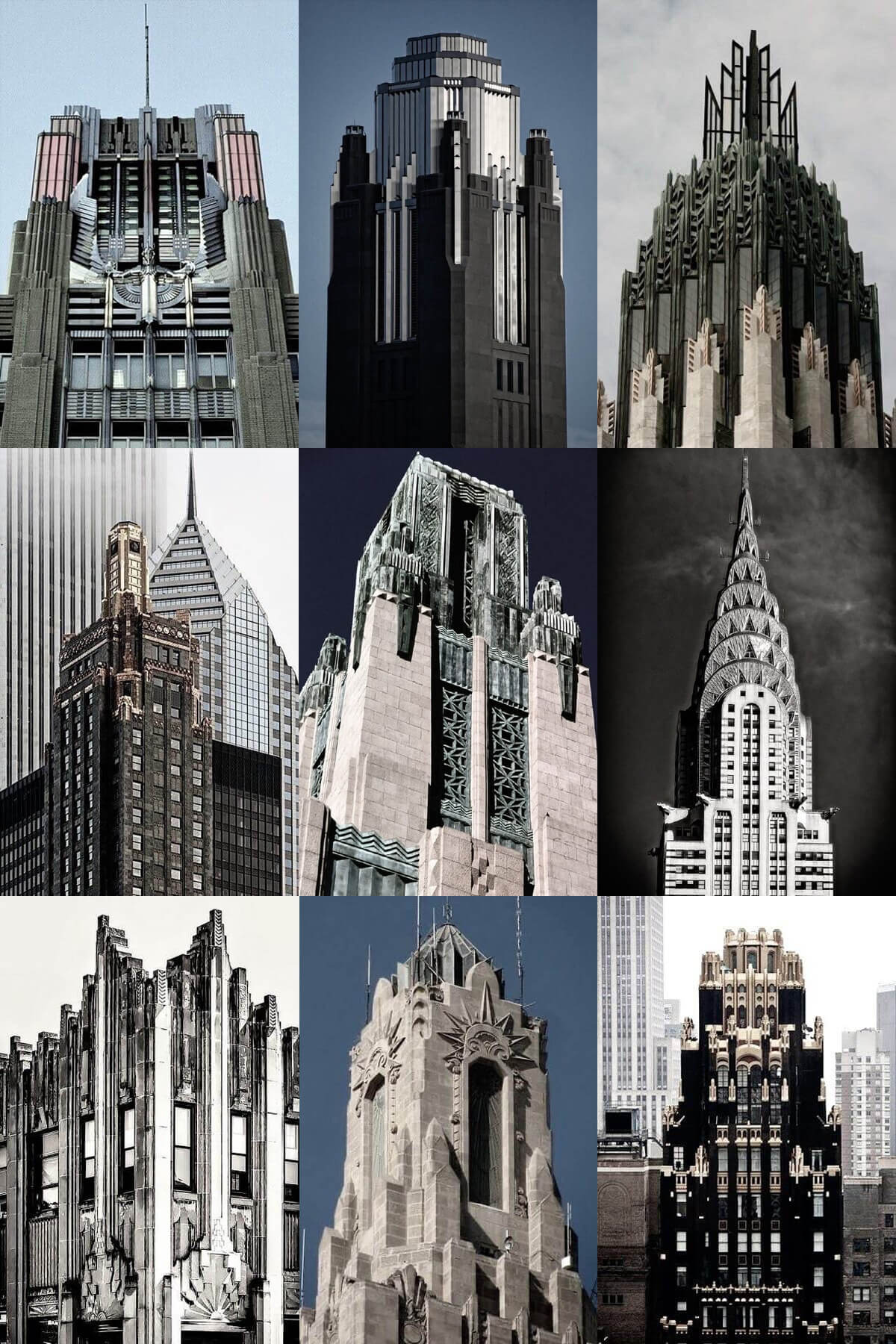
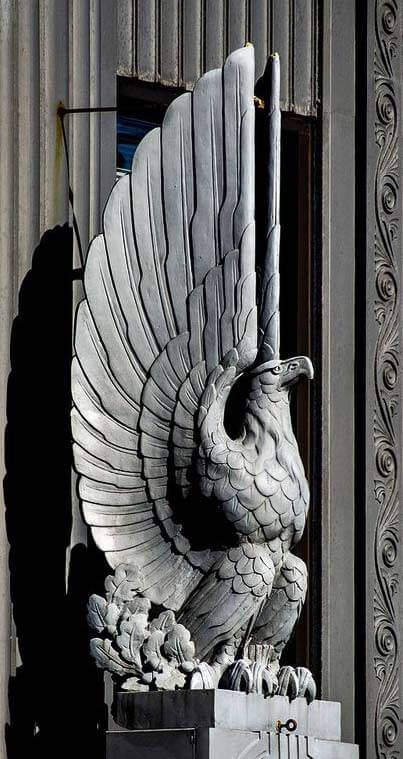
The architectural style of Art Deco is characterized by hard-edged, luxuriously embellished designs accentuated by metal accents. Especially New York City is a hotspot for breathtaking Art Deco architecture.
Most of the architectural buildings of the Art Deco period in American cities have a vertical emphasis of geometric forms, constructed to draw the eye upward. Rectangular, block-like forms are arranged geometrically, with rooftop spires and curved ornamental elements to create a streamlined effect on public buildings.
The New York skyscrapers and the pastel-colored buildings from the Art Deco Historic District in Miami Beach rank among the most famous American examples.
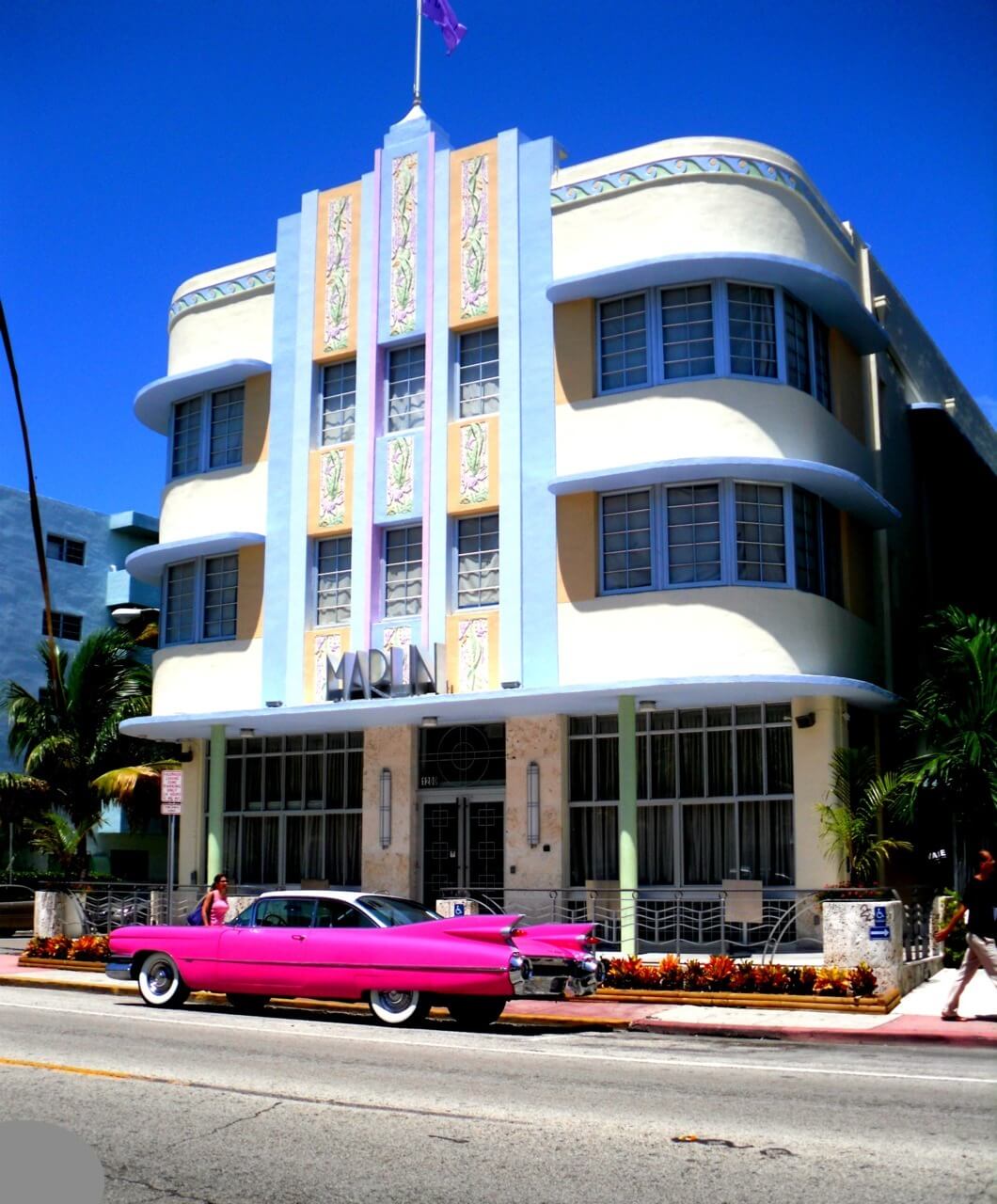
Many of the significant buildings in New York were built during the peak of the Art Deco movement, such as the famous Chrysler Building, which changed the skyline of the city, and was designed by Van Alen in the late 1920s, with the building being completed in 1930. Other examples of famous Art Deco buildings are Residential buildings and the Daily Express Building.
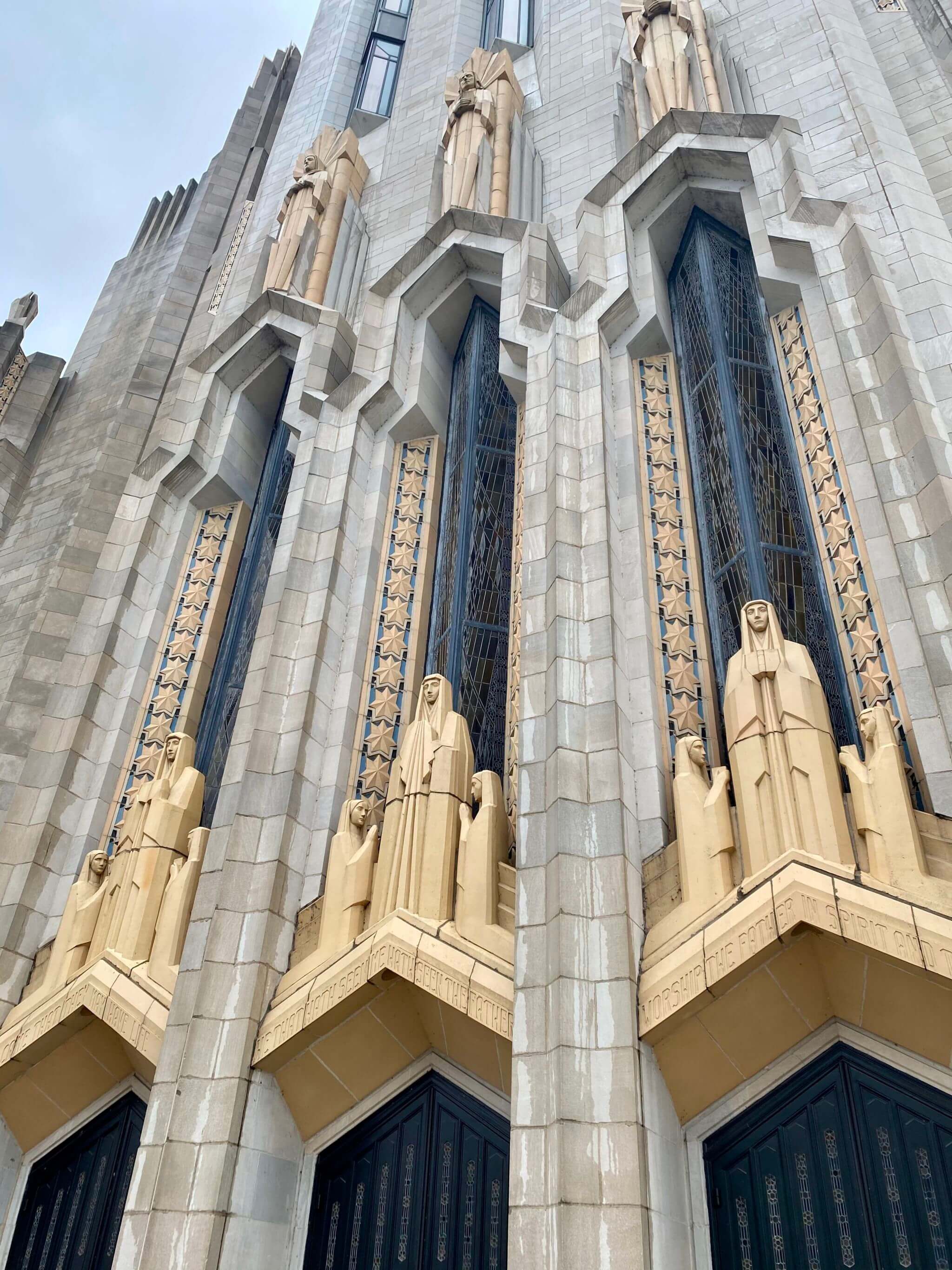
Another prominent example of the Art Deco architectural period is the Golden Gate Bridge, the suspension bridge connecting San Francisco Bay and the Pacific Ocean.
Art Deco paintings and graphic design
Known as the "Painting Baroness," Polish artist Tamara de Lempicka (1898 – 1980) became one of the leading representatives of the Art Deco movement.
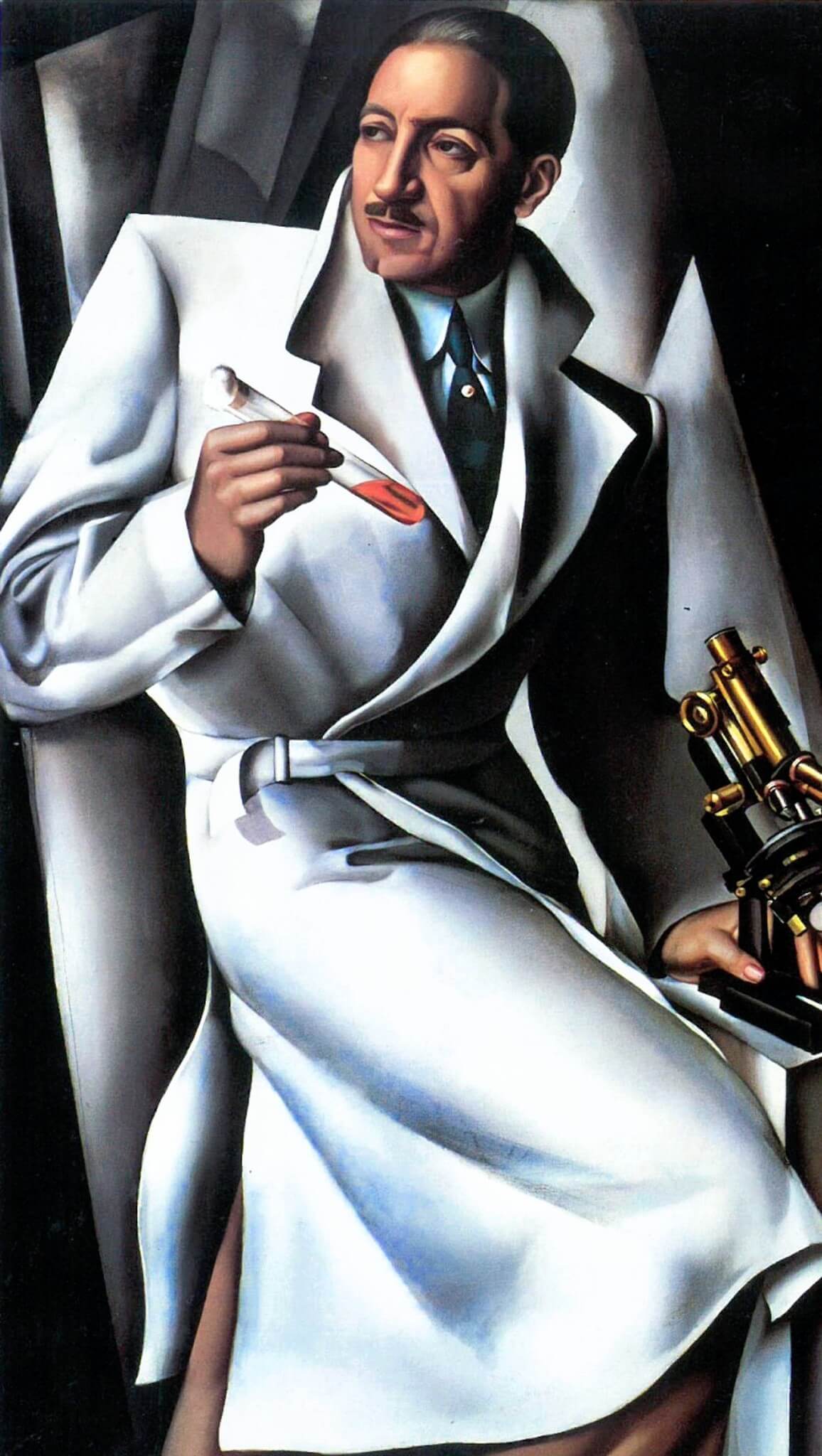
She created her style with elements of synthetic cubism, a phase of cubism that experimented with textures, patterns, and collages. She additionally incorporated the Art Deco features that used advertising photography techniques (such as lighting or focus angles of the subjects) and the prioritization of lines.
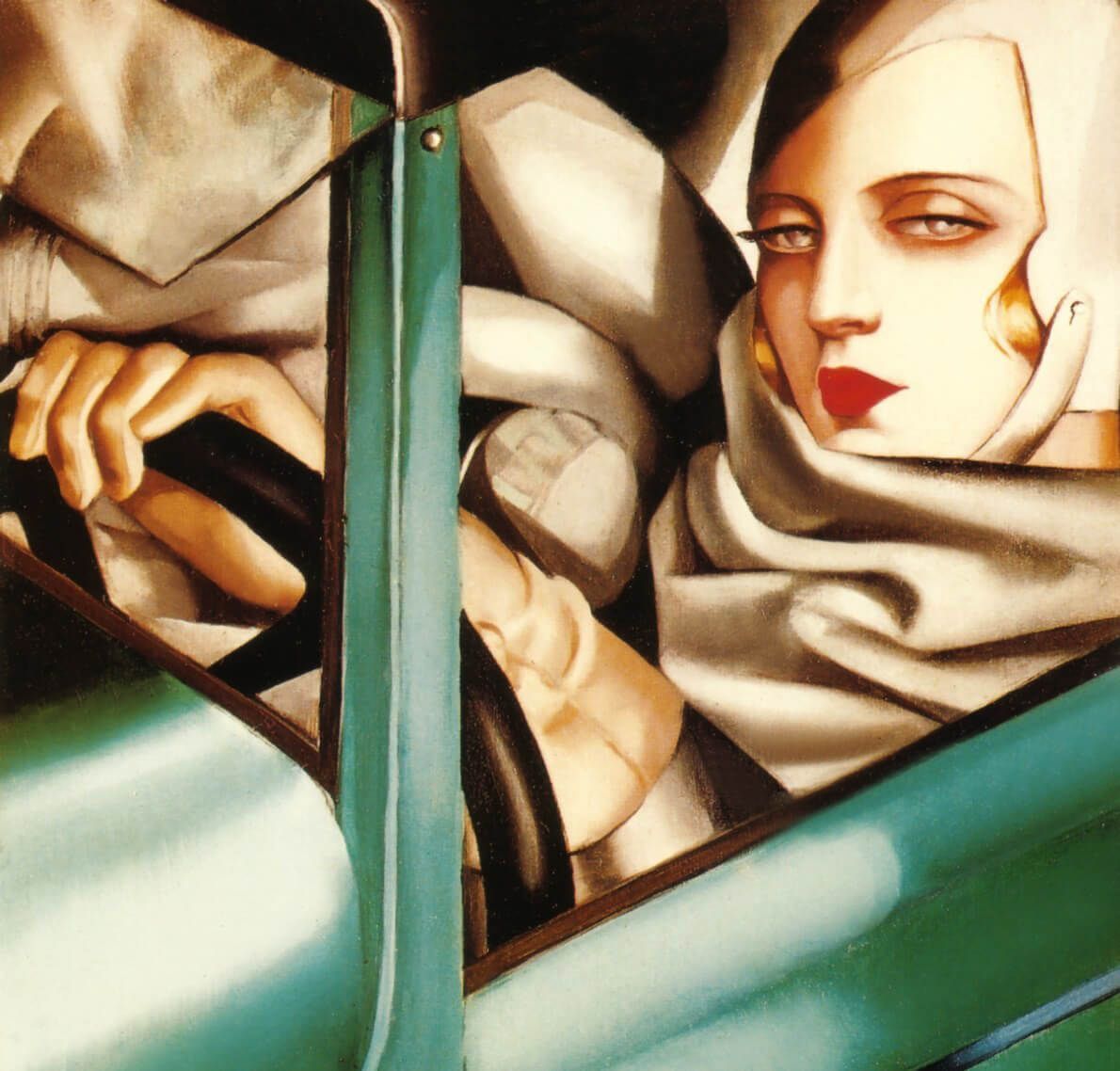
The Self-Portrait in the Green Bugatti (1929) embodies the ideals of Art Deco, technology, and advancement. The angular lines on the modern vehicle and the luxurious attire of Lempicka symbolize the essence of Art Deco.
Art Deco graphic design
The Art Deco style also had a powerful impact on the graphic art of the time. The graphic design showed the influence of Italian Futurism and its devotion to speed progress, and machines. Art Deco heavily influenced prints and posters of the time.
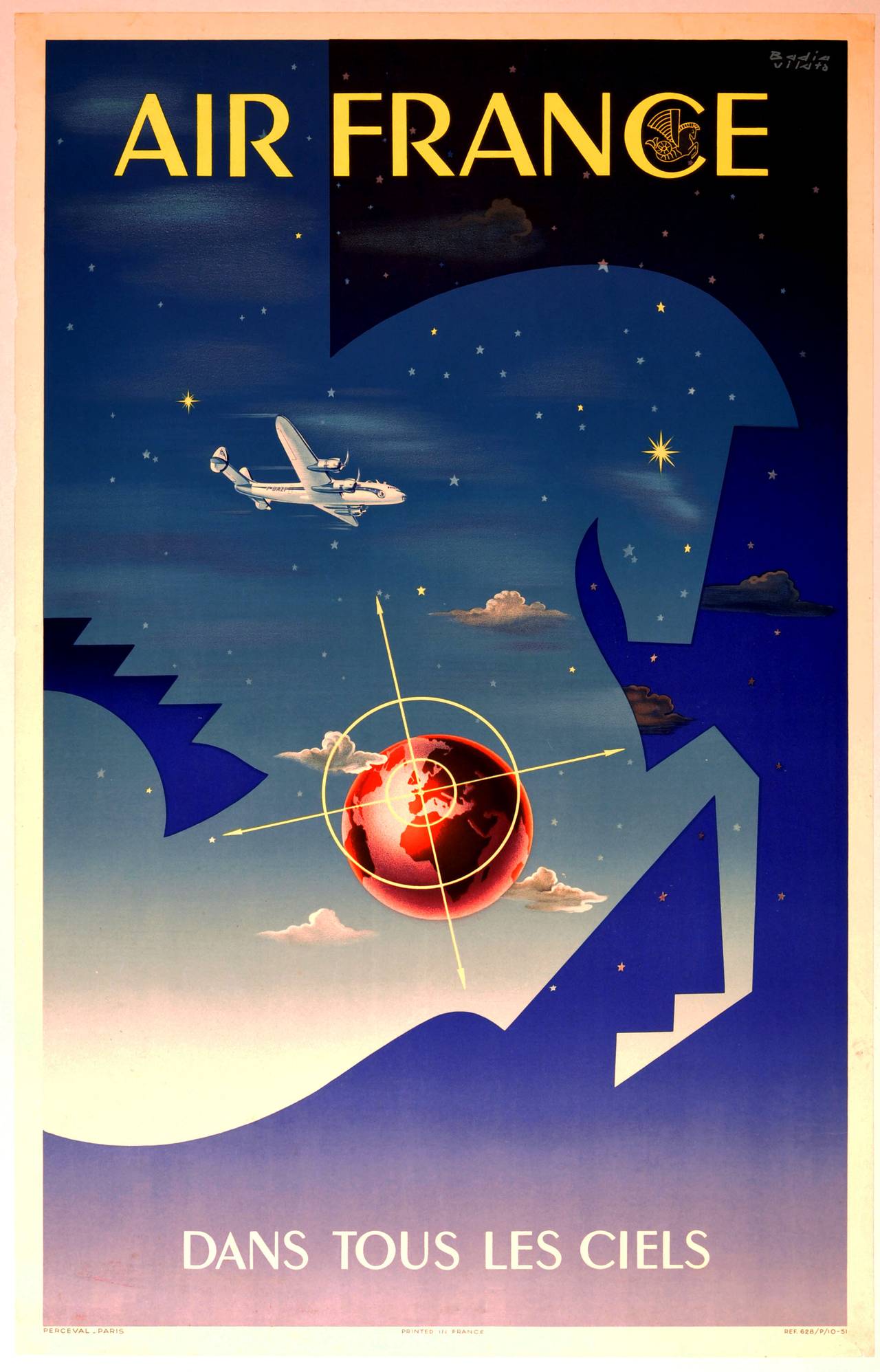
Art Deco prints feature bold geometric forms, sharp angles, and intense colors like Futurism.
Art Deco creatives used the famous futuristic lines in the form of parallel lines, repetitive geometrical shapes, and narrowing forms to indicate the concept of balance, streamlining, and speed.
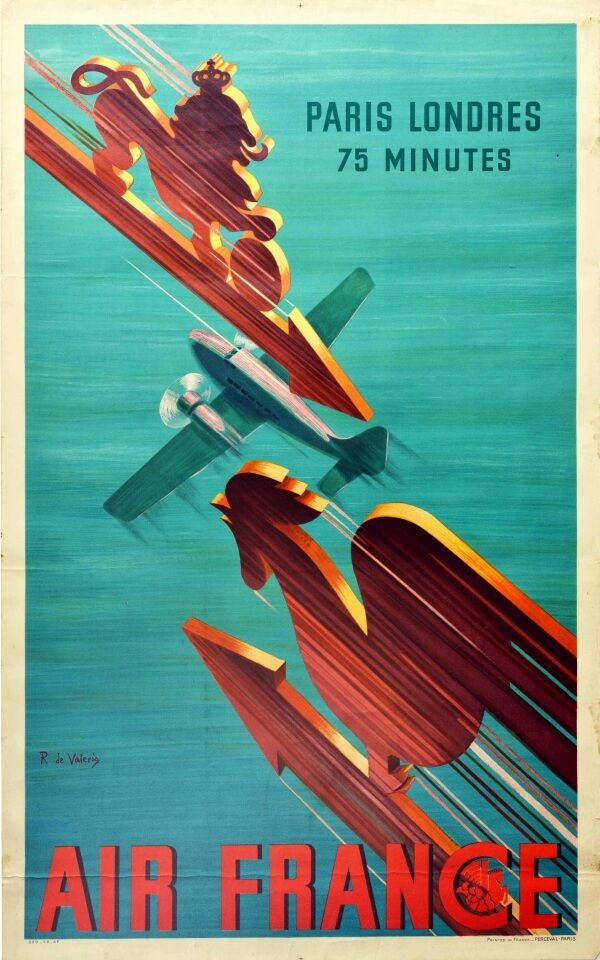
Vast sections of solid colors were used as design elements. These features were similar to Japanese woodblock prints, which Art Deco artists looked to for inspiration. The influx of Japanese art into Europe following the First World War left a significant impact on countries, most notably France.
The woodblock prints mirrored the modern and sleek styles that Art Deco was attempting to emulate.
These are the main attributes of the Art Deco graphic design style:
- Strong use of geometric shapes, especially triangles
- Large areas of unused space
- Strong lines, often with thick strokes and even zigzags
- Strong color palettes with one or two saturated hues
- Typography with thick, additional strokes or strong ornamentation.
- Hard edges
- Chevron patterns
- Mosaic styles
- Images with a flattened look that are more artistic and less realistic
Popular art deco style typefaces were: Anna, Bifur, Broadway, Cormier, Coquette, Mostra Nuova, and Peignot. Graphic designers at the time were interested in the use of images along with language and text to create a powerful and communicative style with illustrative images and geometric lines.
Another common element of the art deco typography style is the use of all caps for lettering. While some typefaces might include lowercase characters, they are not frequently used.
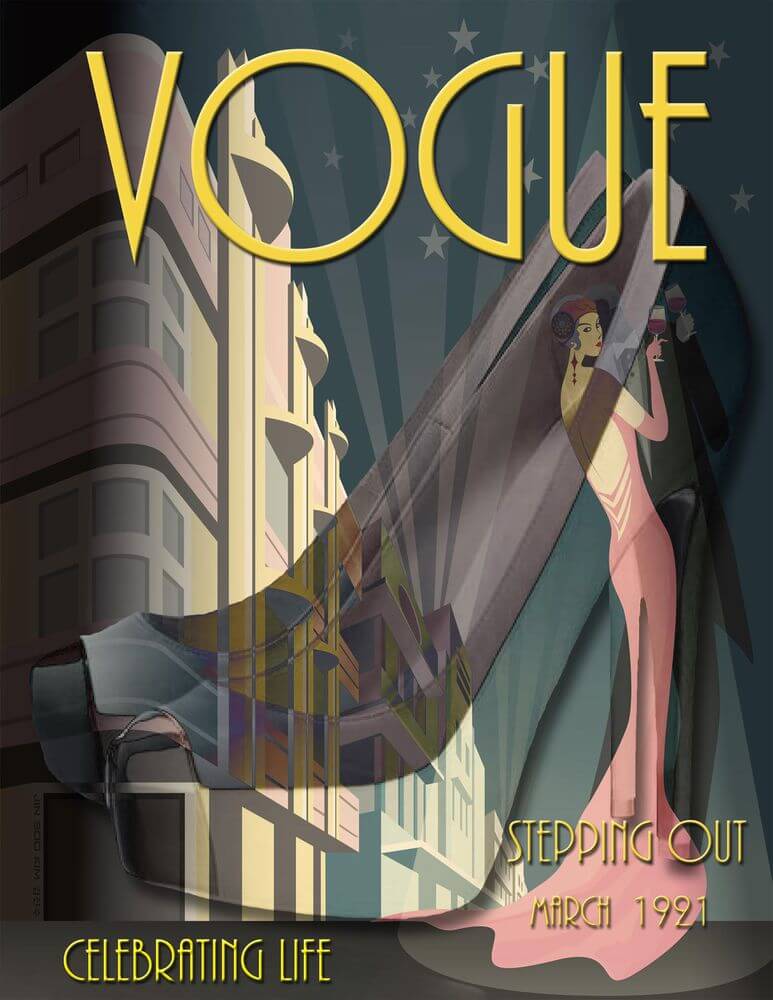
The typefaces are rather ornate but don’t have all the long swashes and tails that give other ornate typefaces a more feminine feel.
For example, the famous poster artist Ernst Deutsch embraced simplified shapes and human figures and bright and blocky color palettes. This style was typical of the new ‘Plakatstil’ (poster style) artists. Ernst designed for Coco Chanel, Bugatti automobiles, and other high-end customers.
Art Deco posters and prints are genuinely iconic, profoundly reforming the taste of the time.
Art Deco film and literature
One of the most famous films of that time that Art Deco heavily influenced is the Film Metropolis by Director Fritz Lang, a German-Austrian filmmaker, screenwriter, graphic artist, painter, and occasional film producer and actor.
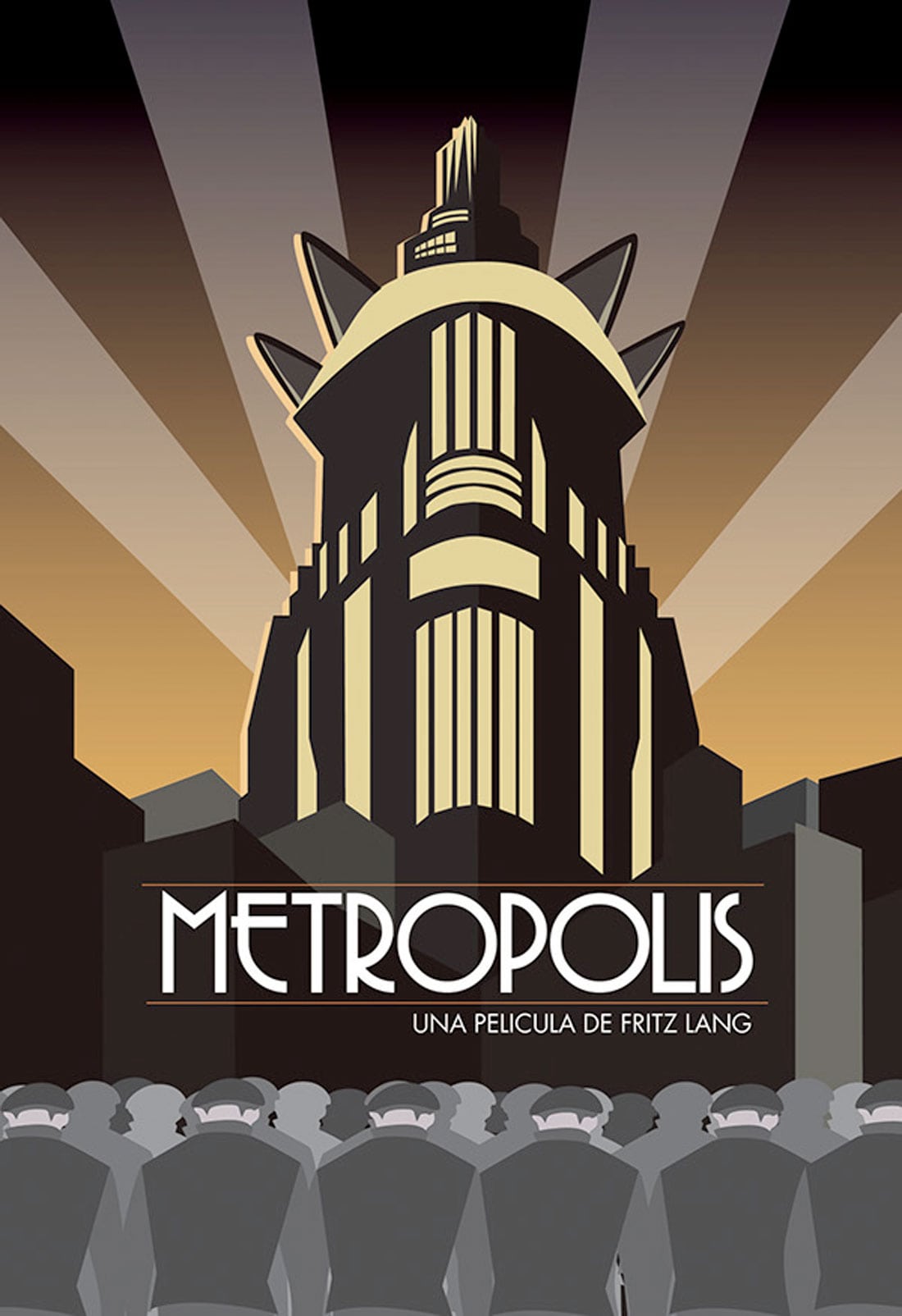
The Art Deco art movement is significantly included in Metropolis's visual and thematic elements. Fritz Lang reported in an interview that ‘the movie was born from my first sight of the skyscrapers in New York in October 1924’ and the film’s model-makers created skyscrapers that reflected both the Bauhaus aesthetics and the emerging Art Deco ideas.
Undoubtedly, Metropolis’ imagery was strongly influenced by Art Deco, and Lang’s use of this movement’s form language was highly influential, contributing decisively to the style’s popularity in Europe and America.
The self-indulgent excess, decadence, luxury, glitz, and forward-thinking during the 20s America were brilliantly depicted in F. Scott Fitzgerald’s iconic novel, The Great Gatsby.

The revival cycles of Art Deco
Art Deco in the 1960s
Art Deco was looked upon poorly throughout the '40s and '50s but saw a resurgence in the '60s. Similar to the '20s, the mood of the '60s was one of optimism, consumerism, and hopefulness. The economy was steady, pop culture and consumerism were flourishing, and the hippie culture celebrated liberation.
The '60s saw the birth of the Pop Art and Postmodern movements, reminiscent of Art Deco. Both styles relied heavily on bold, bright colors and angular, geometric designs - just like Art Deco. The art Historian Bevis Hillier made Art Deco popular again with his book about the style.
“The public began to retake an interest in Art Deco. During the 1960s, Art Deco sites, such as Miami Beach, and key Deco buildings and interiors - including the spectacular Rainbow Room in the RCA building in the Rockefeller Center complex - were stylishly refurbished." (Benton, 2003)
Ready to create brand assets that pack a punch?
Visit our Academy for free art design courses.
Art Deco in the 1970s
The Roaring Twenties are infamous for their prohibition parties, Charleston dancing, and loose moral codes. Likewise, the '70s were all about uber-glam Studio 54 parties and hedonism.
One of the best examples of Art Deco revival in the '70s has to be Big Biba. The London department store boasted marbled floors, mirrors, peacock feather decor, figurative lamps, and geometric patterns. The luxurious interiors were oozing with Art Deco glamour.
Art Deco in the 1980s
The 1980s were all about excess, luxury, and status. The "ME" generation glorified real estate tycoons like Donald Trump and the young hotshots of Wall Street. The Art Deco period's bold colors and strong geometric made their comeback. This time around, the colors got even more daring. The neon colors of the 80s were so intense that they almost burned your retina.
In graphic design, fashion and jewelry silhouettes were influenced heavily by the angular, geometric designs of the Art Deco era.
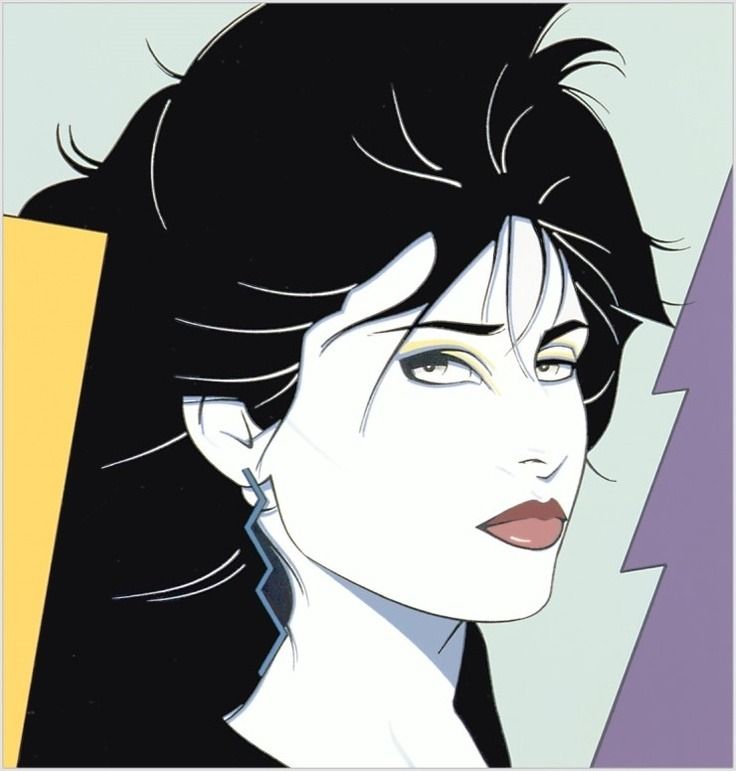
Miami Vice was one of the most popular television shows - putting a bright, neon spotlight on the South Beach Art Deco District.
The culture of the 1980s was reminiscent of the 1920's luxury, leisure, and technology. The 1980's lifestyle was reminiscent of the hedonistic, pleasure-seeking days of Art Deco.
Art Deco also inspired the Memphis Group, a design and architecture movement centered in Milan during the 1980s. The Memphis Group drew its inspiration from Pop art and Kitsch and for its colorful, postmodern designs.
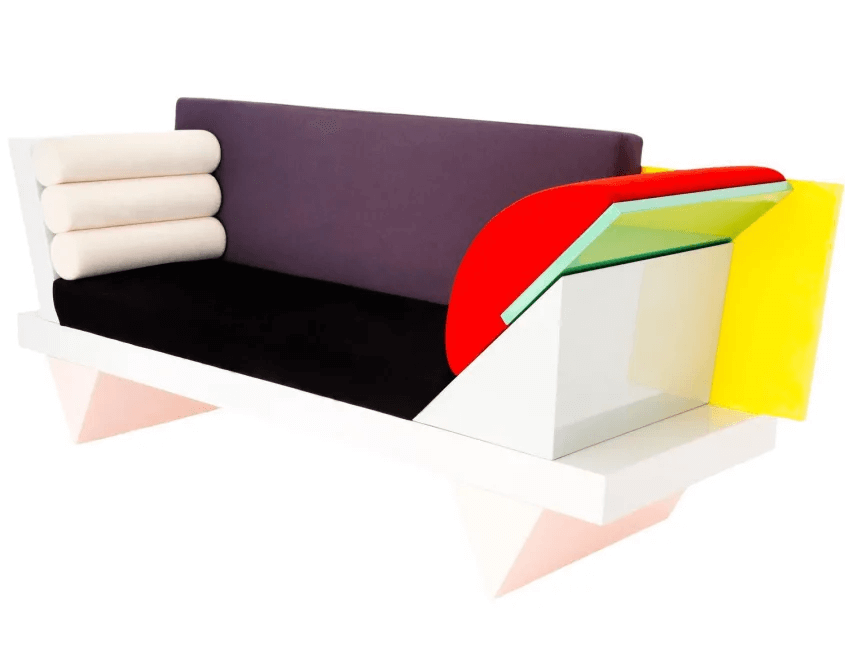
Neo Art Deco today
The fascination with Art Deco never seems to go away. Popular Art Deco destinations like South Beach, Miami, New York, Montreal, Havana, and Paris are more popular than ever. Art Deco enthusiasts continue to attend annual Art Deco Congresses and 'Art Deco Weekend' festivals.
The release of Baz Luhrmann's 'The Great Gatsby,' a movie in 2013, created a frenzy for all things Art Deco.
Even in the 2020s, the influence of the bold, geometric and luxurious art deco is visible in graphic design and interior decorating:

The bold and rich color palette and the geometric forms made a dramatic return as Neo Art Deco in the post-pandemic era.
Art styles come and go in cycles. The Art Deco style is favored in periods that symbolize progress, consumerism, and decadence.
Now that Art Deco is emerging again, let us interpret it as a sign of a new dawn of progress and luxury!
Linearity Curve (formerly Vectornator), with its precise and sharp vector-based path tools and lines, is optimal for creating geometric Art Deco designs.
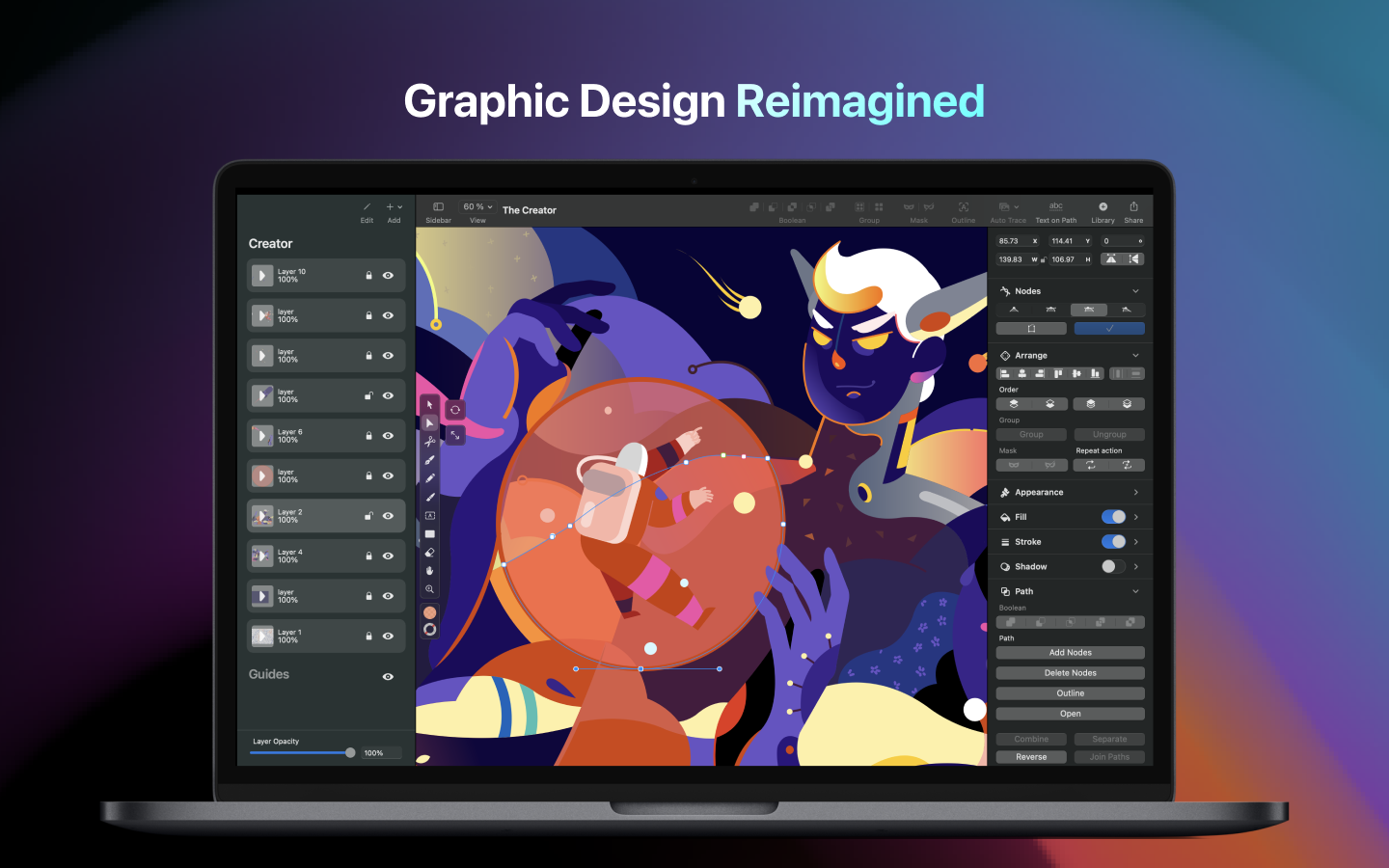
The Pen Tool in Curve allows you to create sharp geometric shapes with precise path controls like Bézier Curves and different Node types. The finished geometric shapes and the vector path can be modified precisely afterward with the Node Tool.
The vector shapes can be scaled and exported seamlessly without any resolution and image size limitations. You can import any reference image, set up a grid, and activate snapping functions to create the desired sharpness and precision.
If this article inspires you to create your own Art Deco-inspired vector shapes, download Linearity Curve for free to get started!
Jumpstart
your ideas with
Linearity Curve
Take your designs to the next level.
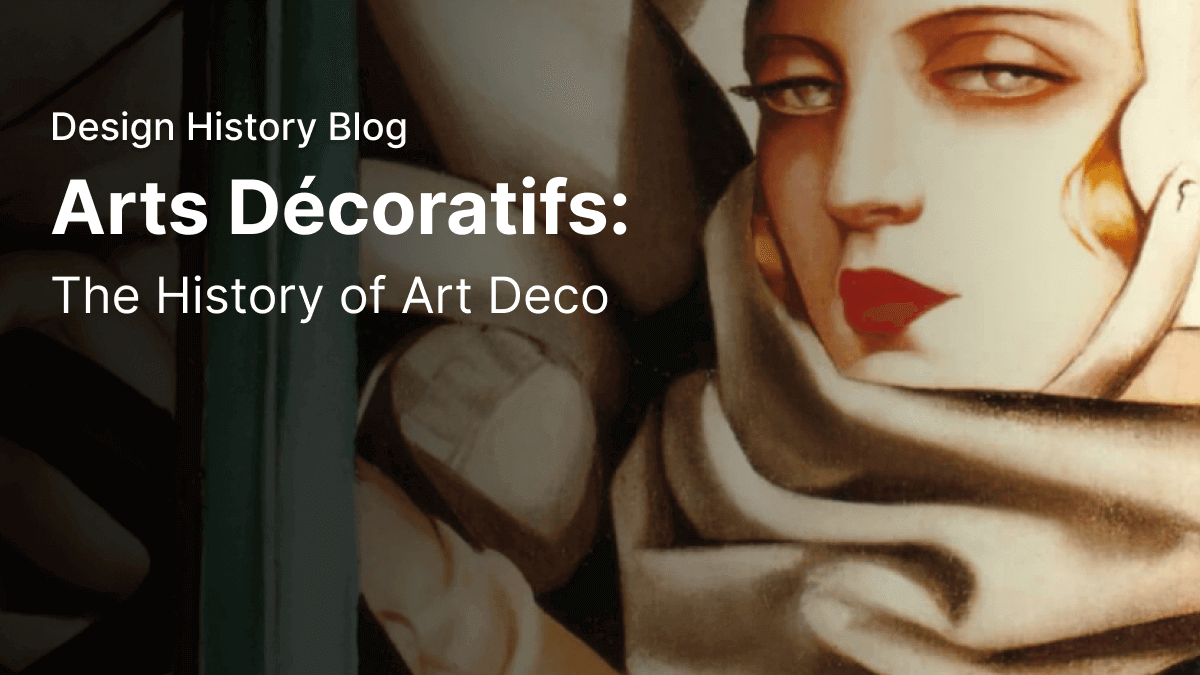
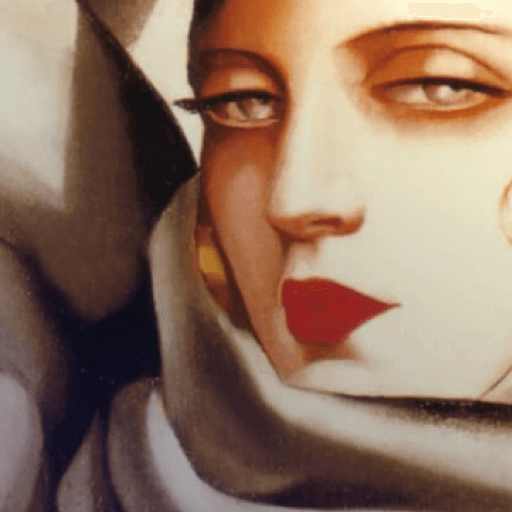
Share this!
Marion Gerlinger
Marion is a contributing writer to the Linearity Blog.


:quality(75))
:quality(75))


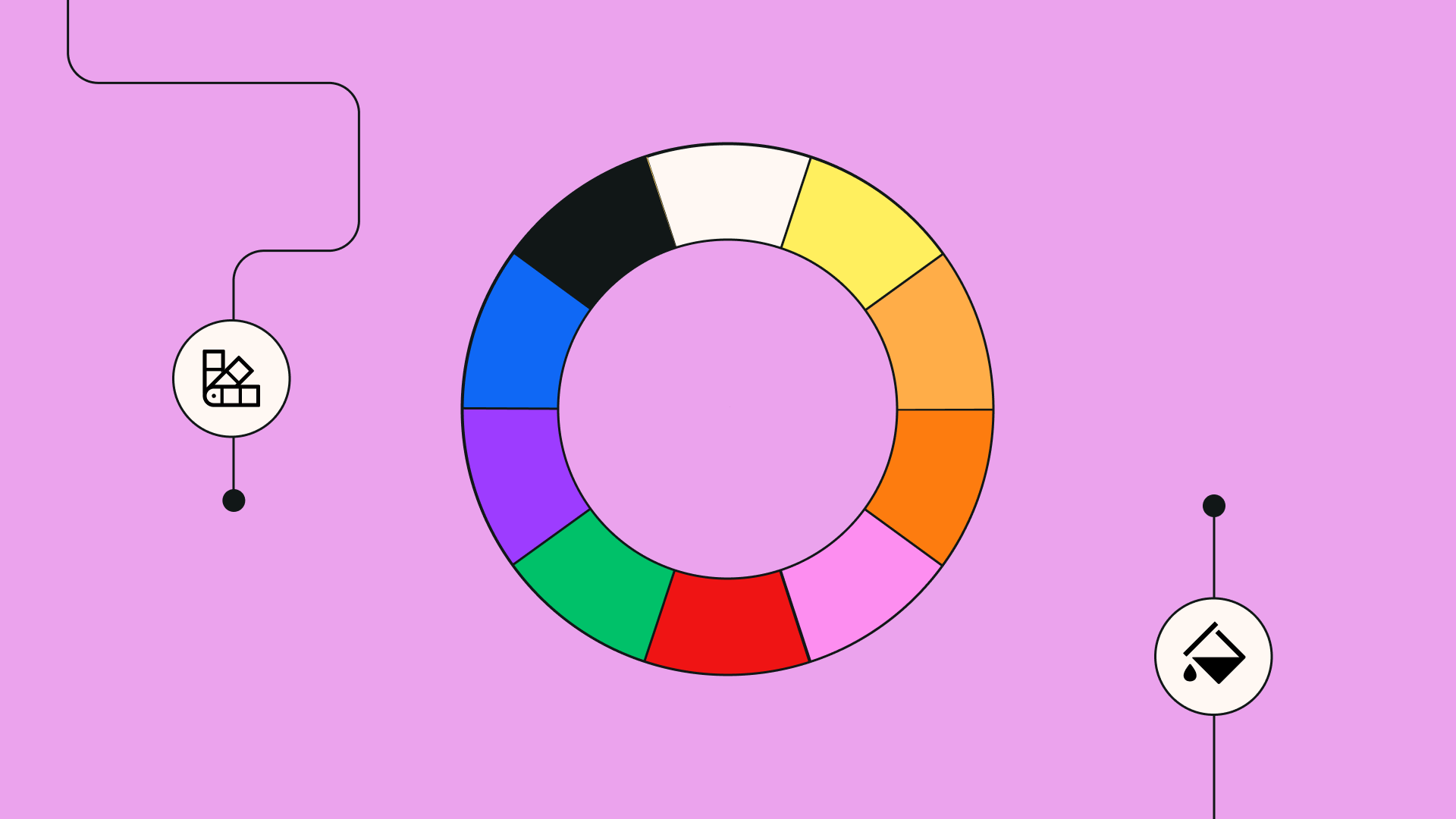
:quality(75))
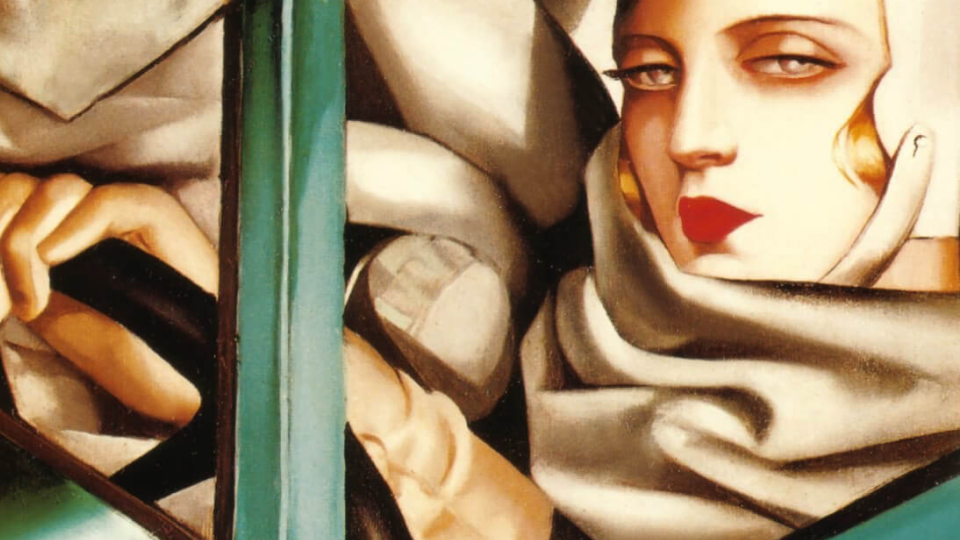
:quality(75))
:quality(75))
